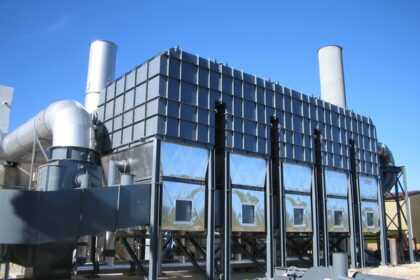ROTO Concentrator
Typical duty is to treat process flows between 25,000 to 300,000 Nm3/h containing low levels of VOC’s. A roto-concentrator is a zeolite charged rotating wheel which temporarily adsorbs VOC’s onto the matrix thereby removing them from the effluent stream and, in turn, provides a much lower flowrate VOC rich stream for treatment by traditional Oxidation techniques. It is easy to use, very effective in reducing VOC emissions, safe and highly cost-effective compared with other technologies such as active carbon filtration.
Design & Operation
The rotating wheel is a honeycomb structure formed by a matrix containing zeolites. Zeolites are microporous aluminosilicate materials which provide a very large surface area for the adsorption of VOC species. The roto-concentrator rotates with a variable speed, typically 1 to 3 revolutions/hour, depending on process conditions.
90 to 95% of the process effluent flow passes through the roto-concentrator wheel and on to the chimney, with the VOC’s being temporarily adsorbed onto the zeolite.
The remaining 5-10% of the flow is heated and passed through a section of the roto-concentrator wheel where the heat causes the VOC’s to desorb from the zeolite matrix returning it, after a subsequent cooling stage, to the required condition to continue the cycle. This more highly concentrated stream is than treated in an oxidiser (usually in a regenerative oxidiser which can often work in Auto Thermal operation) which is downstream the roto-concentrator. This greatly reduces or eliminates the support fuel required to treat the total process flow stream.
Advantages
- Able to handle a high volume of effluent air with a wide range of VOCs, in a very cost-effective manner
- Abatement rate > 98%
- Smoothing of VOC concentration peaks gives very reliable emissions
- Low energy consumption
- Reducing by 10 times or more, the size of the regenerative oxidiser for the required process flow
- Long lasting wheel construction (no periodic replacement required)
- Friendly user operating system
- Low maintenance costs
- Reduced floor space required compared with other technologies to treat the same process flow




















